light PONTIAC GRAND-PRIX 1993 Owners Manual
[x] Cancel search | Manufacturer: PONTIAC, Model Year: 1993, Model line: GRAND-PRIX, Model: PONTIAC GRAND-PRIX 1993Pages: 338, PDF Size: 17.3 MB
Page 4 of 338
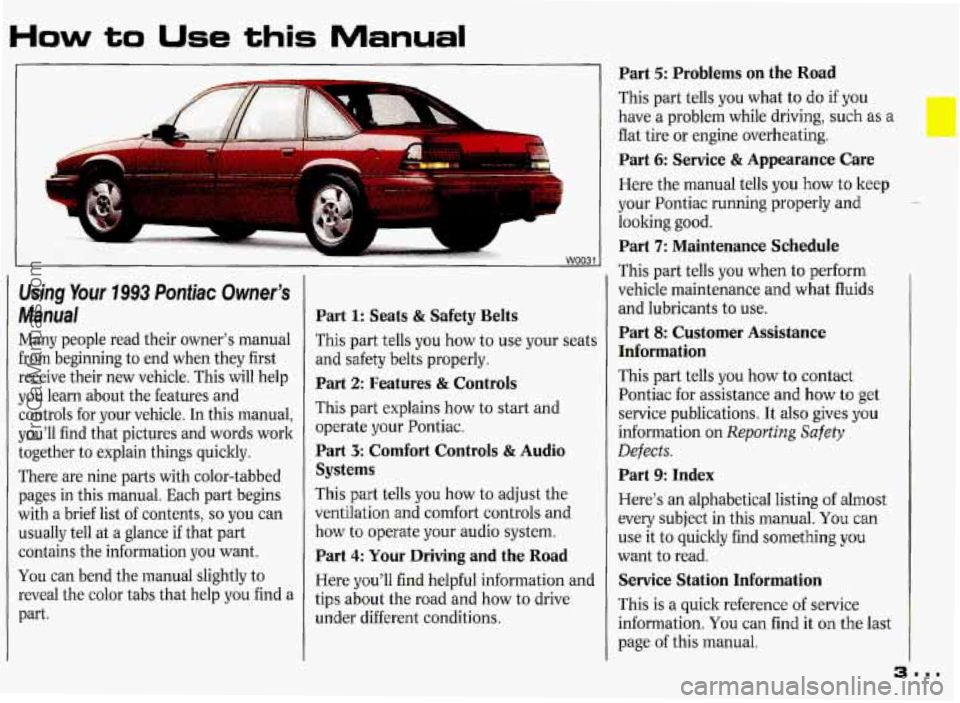
How to Use this Manual
b
Using Your 1993 Pontiac Owner’s
Manual
Many people read their owner’s manual
from beginning to end when they first
receive their new vehicle. This will help
you learn about the features and
controls for your vehicle. In this manual,
you’ll find that pictures and words work
together to explain things quicltly.
There are nine parts with color-tabbed pages in this manual. Each part begins
with a brief list of contents,
so you can
usually tell at a glance if that part
contains the information you want.
You can bend the manual slightly to
reveal the color tabs that help you find a
part.
Part 1: Seats & Safety Belts
This part tells you how to use your seat:
and safety belts properly.
Part 2: Features 8z Controls
This part explains how to start and
operate your Pontiac.
Part 3: Comfort Controls & Audio
Systems
This part tells you how to adjust the
ventilation
and comfort controls and
how to operate your audio system.
Part 4: Your Driving and the Road
Here you’ll find helpful information anc
tips about the road and how to drive
under different conditions.
Part 5: Problems on the Road
This part tells you what to do if you
have a problem while driving, such as a
flat tire or engine overheating.
Part 6: Service & Appearance Care
Here the manual tells you how to keep
your Pontiac running properly and
looking good.
Part 7: Maintenance Schedule
This part tells you when to perform
vehicle maintenance and what fluids
and lubricants to use.
Part 8: Customer Assistance
Information
This part tells you how to contact
Pontiac for assistance and how
to get
service publications. It also gives you
information on
Reporting Safety
Defects.
Part 9: Index
Here’s an alphabetical listing of almost
every subject in this manual.
You can
use it to quicltly find something
you
want to read.
Service Station Information
This is a quick reference of service
information.
You can find it on the last
page of this manual.
~~.
ProCarManuals.com
Page 6 of 338
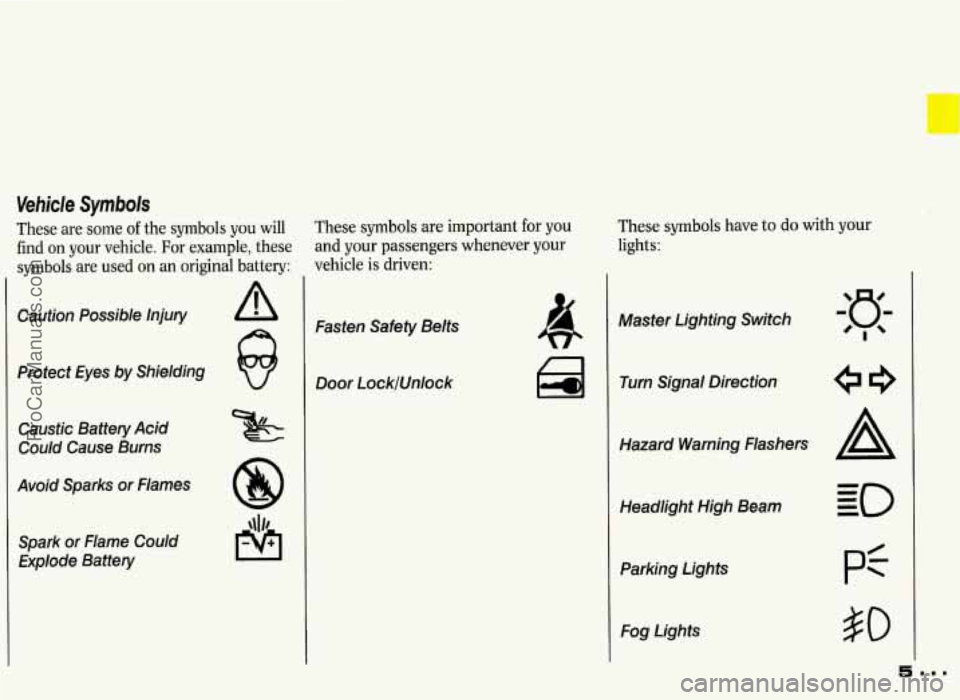
c
Vehicle Symbols
These are some of the symbols you will
find on your vehicle. For example, these
symbols are used
on an original battery:
I
Caution Possible Injury
Protect Eyes by Shielding
Caustic Battery Acid
Could Cause Burns
Avoid Sparks
or Flames
Spark or Flame Could
Explode Battery
These symbols are important for you
and your passengers whenever your
vehicle is driven:
Fasten Safety Belts
Door LocklUnlock
These symbols have to do with your
lights:
a Turn Signal Direction
Hazard Warning Flashers
Headlight High Beam
Parking Lights Fog Lights
ProCarManuals.com
Page 7 of 338
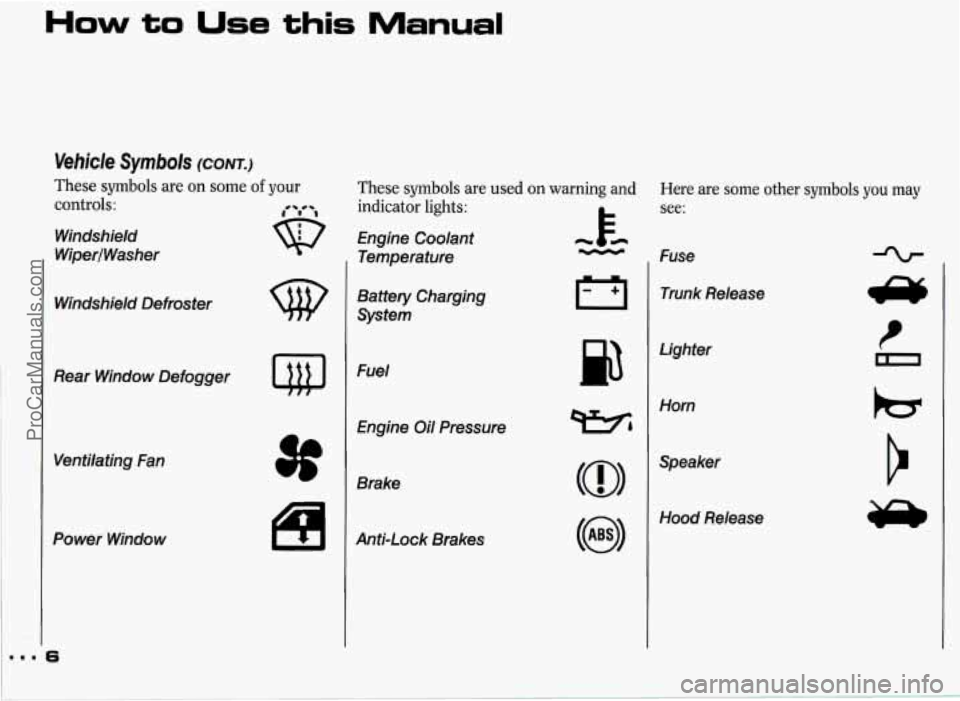
How to Use this Manual
Vehicle Symbols (CQNT.)
These symbols are on some of your
controls:
Windshield
WiperlWasher
Windshield Defroster
Rear Window Defogger
Ventilating Fan
Power Window
These symbols are used on warning and
indicator lights:
Engine Coolant - Fd
Temperature .HccF
Battery Charging
System
Fuel
Engine Oil Pressure
Brake
Anti-Lock Brakes
Here are some other symbols you may
see:
Fuse
Trunk Release
Lighter
Horn
Speaker
Hood Release
ProCarManuals.com
Page 16 of 338
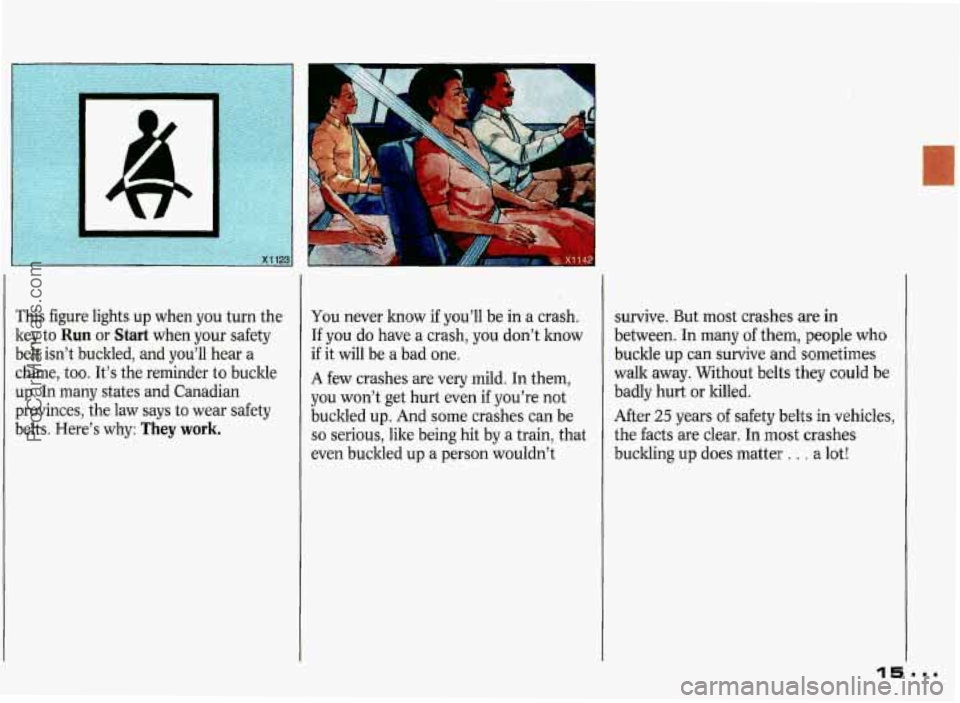
This figure lights up when you turn the
key to
Run or Start when your safety
belt isn’t buckled, and you’ll hear a
chime, too. It’s the reminder to buckle
up.
In many states and Canadian
provinces, the law says to wear safety
belts. Here’s why:
They work.
You never know if you’ll be in a crash.
If you do have a crash, you don’t know
if it will be a bad one.
A few crashes are very mild. In them,
you won’t get hurt even if you’re not
buckled
up. And some crashes can be
so serious, like being hit by a train, that
even buckled
up a person wouldn’t survive. But
most crashes are in
between. In many
of them, people who
buckle up can survive and sometimes
walk away. Without belts they could
be
badly hurt or killed.
After
25 years of safety belts in vehicles,
the facts are clear.
In most crashes
buckling
up does matter . . . a lot!
ProCarManuals.com
Page 20 of 338
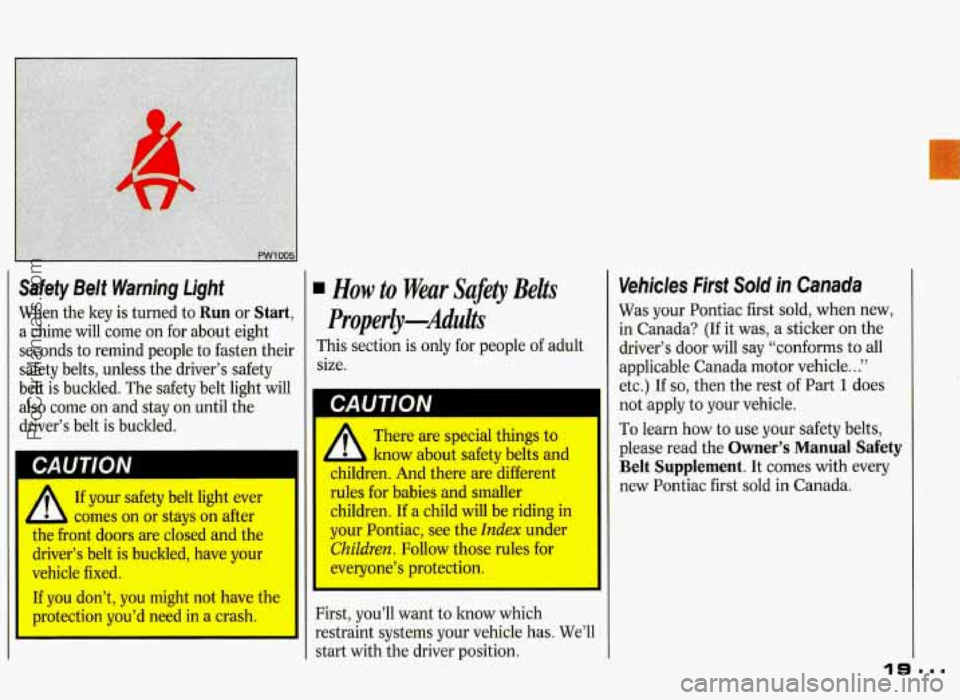
Safefy Belt Warning Light
When the key is turned to Run or Start,
a chime will come on for about eight
seconds to remind people
to fasten their
safety belts,
unless the driver‘s safety
belt
is buckled. The safety belt light will
also come on and stay on until the
driver’s belt is buckled.
CAUTION
If your safety belt light ever
tllc iont doors are closed and the
driver’s belt is buckled, have your
vehicle fixed.
If you don’t, you might not have the
protection you’d need in a crash.
h comes on or stays on after
This s6ction is only for people of adult
size.
I CAUTION
* There are special things to
2 know about safety belts and
children. And there are different
rules for babies and smaller
children.
If a child will be riding in
your Pontiac, see the
Index under
ChiZdren. Follow those rules for
everyone’s protection.
First, you’ll want
to how which
restraint
systems your vehicle has. We’ll
I start with the driver position.
Vehicles; Firsf SoEd in Canada
Was your Pontiac first sold, when new,
in Canada? (If it was, a sticker on the
driver’s door will say “conforms to all
applicable Canada motor vehicle.. .”
etc.) If so, then the rest of Part 1 does
not apply ta your vehicle.
To learn how to use your safety belts,
please read the Owner’s Manual Safety
Belt Supplement. It comes with every
new Pontiac first sold in Canada.
ProCarManuals.com
Page 44 of 338
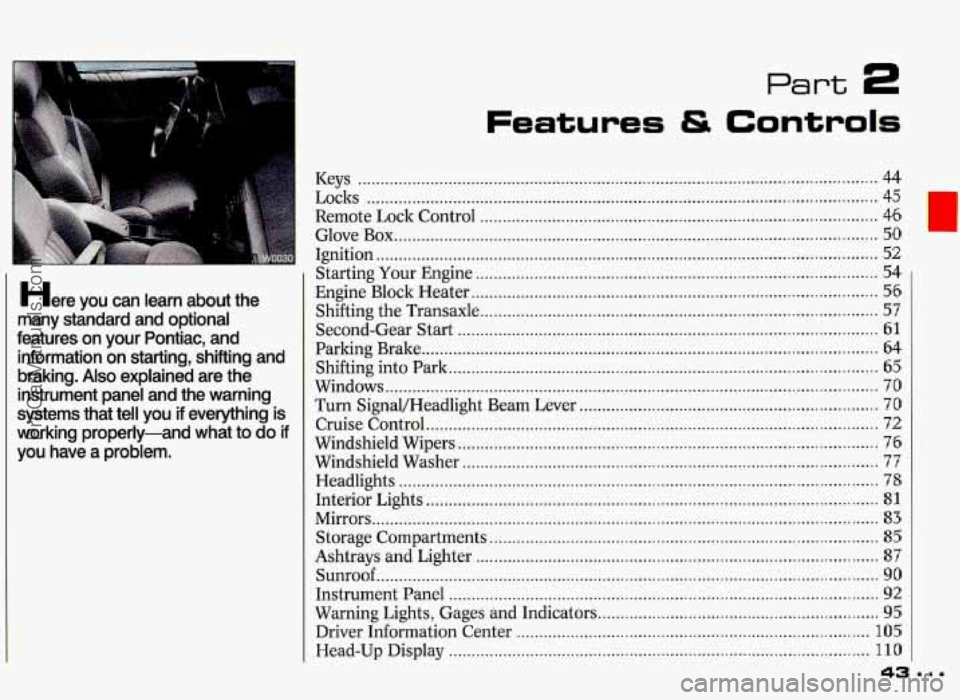
Here you can learn about the
many standard and optional
features on your Pontiac. and information on starting. shifting and
braking
. Also explained are the
instrument panel and the warning
systems that tetl you if everything is
working properly-and what to
do if
you have a problem .
Features & Controls
Keys ........................................................................\
........................................... 44
Locks ........................................................................\
......................................... 45
Remote Lock Control ........................................................................\
................ 46
Glove Box ........................................................................\
................................... 50
Ignition ........................................................................\
....................................... 52
Starting Your Engine ........................................................................\
................. 54
Engine Block Heater ........................................................................\
.................. 56
Shifting the Transaxle ........................................................................\
................ 57
Second-Gear Start ........................................................................\
..................... 61
Parking Brake ........................................................................\
............................. 64
Shifting into Park ........................................................................\
....................... 65
Windows ........................................................................\
..................................... 70
Turn Signal/Headlight Beam Lever .................................................................. 70
Cruise Control ........................................................................\
............................ 72
Windshield Wipers ........................................................................\
..................... 76
Windshield Washer ........................................................................\
.................... 77
Headlights ........................................................................\
.................................. 78
Interior Lights ........................................................................\
............................ 81
Mirrors ........................................................................\
........................................ 83
Storage Compartments ........................................................................\
.............. 85
Ashtrays and Lighter ........................................................................\
................. 87
Sunroof ........................................................................\
....................................... 90
Instrument Panel ........................................................................\
....................... 92
Warning Lights, Gages and Indicators .............................................................. 95
Driver Information Center ........................................................................\
...... 105
Head-Up Display ........................................................................\
..................... 110
ProCarManuals.com
Page 47 of 338
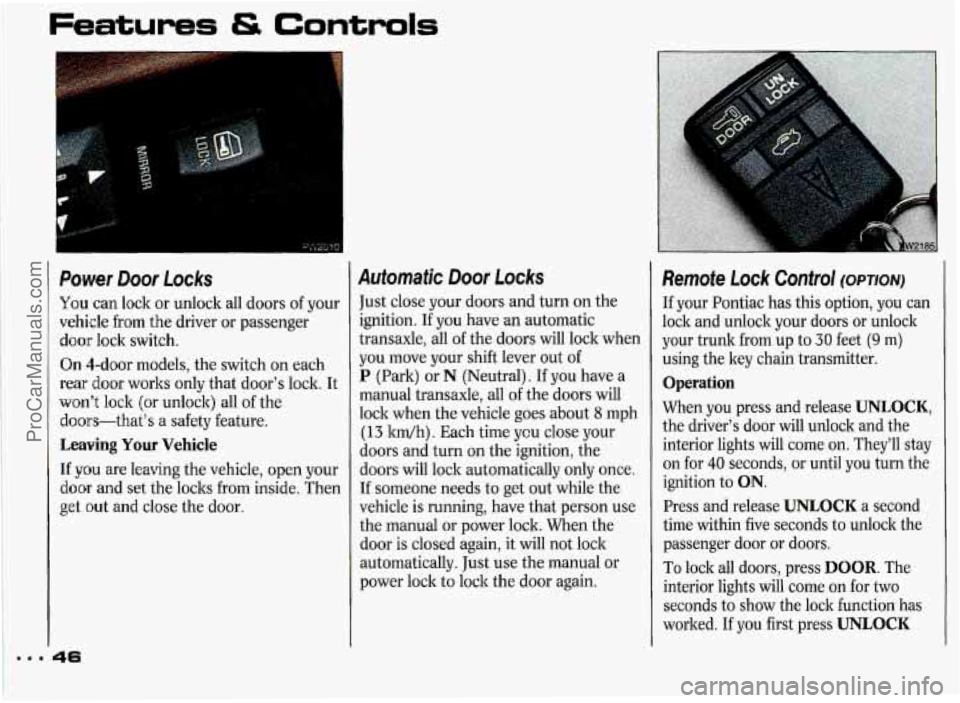
Features & Controls
Power Door Locks
You can lock or unlock all doors of your
vehicle from the driver or passenger
door lock switch.
On 4-door models, the switch on each
rear door works only that door’s lock. It
won’t lock (or unlock) all of the
doors-that’s a safety feature.
Leaving Your Vehicle
If you are leaving the vehicle, open your
door and set the loclss from inside. Then
get
out and close the door.
Automatic Door Locks
Just close your doors and turn on the
ignition.
If you have an automatic
transaxle, all
of the doors will loclt when
you move your shift lever out of
P (Park) or N (Neutral). If you have a
manual transaxle, all of the doors will
lock when the vehicle goes about
8 mph
(13 ltrn/h). Each time ycu close your
doors and turn on the ignition, the
doors will lock automatically only once.
If someone needs to get out while the
vehicle is running, have that person use
the manual or power loclt. When the
door is closed again, it will not lock
automatically. Just use the manual
or
power lock to lock the door again.
Remote Lock Control (OPTION)
If your Pontiac has this option, you can
lock and unlock your doors or unlock
your trunk from up to
30 feet (9 m)
using the key chain transmitter.
Operation
When you press and release UNLOCK,
the driver’s door will unlock and the
interior lights will come on. They’ll stay
on for
40 seconds, or until you turn the
ignition to
ON.
Press and release UNLOCK a second
time within five seconds to unlock the
passenger door or doors.
To loclt all doors, press DOOR. The
interior lights will come on for two
seconds to show the lock function has
worked. If you first press
UNLOCK
ProCarManuals.com
Page 48 of 338
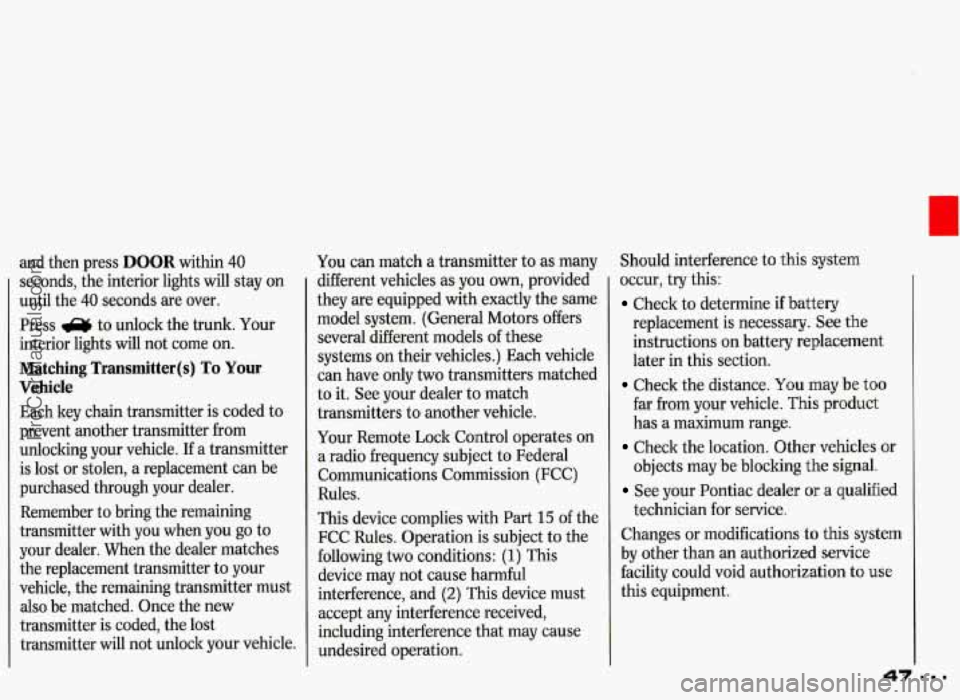
and then press DOOR within 40
seconds, the interior lights will stay on
until the 40 seconds are over.
Press
a to unlock the trunk. Your
interior lights will not come
on.
Matching Transmitter(s) To Your
Vehicle
Each key chain transmitter is coded to
prevent another transmitter from
unlocking your vehicle.
If a transmitter
is lost or stolen, a replacement can be
purchased through your dealer.
Remember to bring the remaining
transmitter with you when you go to
your dealer. When the dealer matches
the replacement transmitter to your
vehicle, the remaining transmitter must
also be matched. Once the new
transmitter is coded, the lost
transmitter will not unlock your vehicle.
You can match a transmitter to as many
different vehicles as you
own, provided
they are equipped with exactly the same
model system. (General Motors offers
several different models of these
systems on their vehicles.) Each vehicle
can have only two transmitters matched
to it. See your dealer to match
transmitters to another vehicle.
Your Remote Lock Co~ntrol operates
on
a radio frequency subject to Federal
Communications Commission (FCC)
Rules.
This device complies with Part
15 of the
FCC Rules. Operation is subject to the
following two conditions:
(1) This
device may not cause harmful
interference, and
(2) This device must
accept any interference received,
including interference that may cause
undesired operation. Should interference
to this system
occur, try this:
Check to determine if battery
replacement is necessary. See the
instructions
on battery replacement
later in this section.
Check the distance. You may be too
far from your vehicle. This product
has a maximum range.
Check the location. Other vehicles or
objects may be blocking the signal.
See your Pontiac dealer or a qualified
technician for service.
Changes or modifications to this system
by other than an authorized service
facility could void authorization to
use
this equipment.
ProCarManuals.com
Page 50 of 338
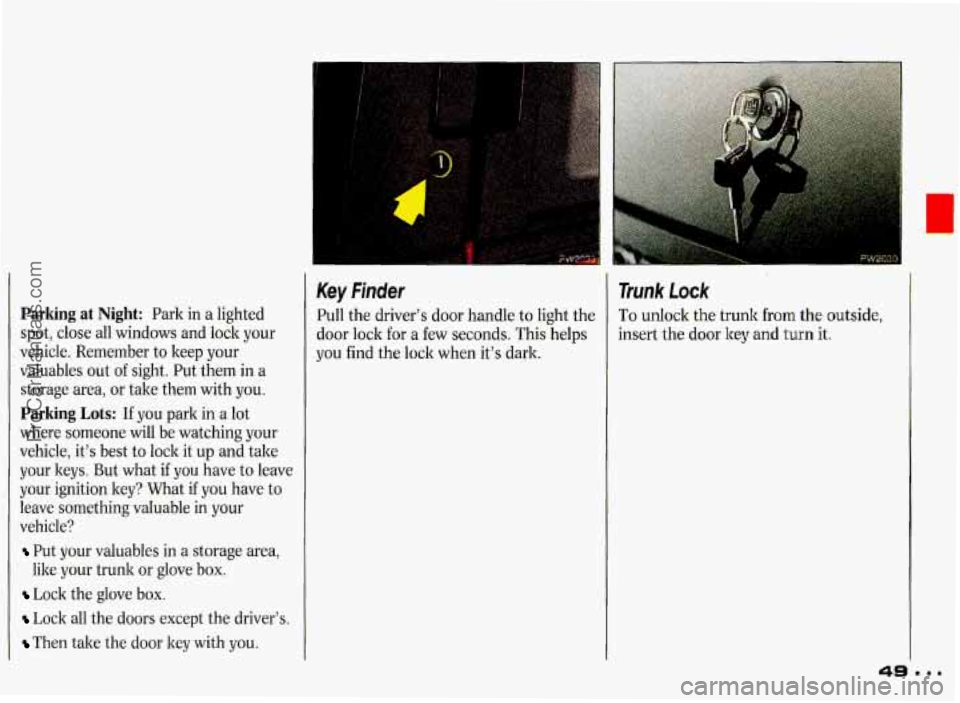
Parking at Night: Park in a lighted
spot, close all windows and lock your
vehicle. Remember to keep your
valuables out
of sight. Put them in a
storage area, or take them with you.
Parking Lots: If you park in a lot
where someone will be watching your
vehicle, it’s best to lock it
up and take
your keys. But what if you have to leave
your ignition key? What if
you have to
leave something valuable in your
vehicle?
Put your valuables in a storage area,
Lock the glove box.
Lock all the doors except the driver’s.
Then take the door key with you.
like your
trunk or glove
box.
Key Finder
Pull the driver’s door handle to light the
door
Iock for a few seconds. This helps
you find the
lock when it’s dark.
Trunk Lock
To unlock the trunk from the outside,
insert the door key and
turn it.
ProCarManuals.com
Page 53 of 338
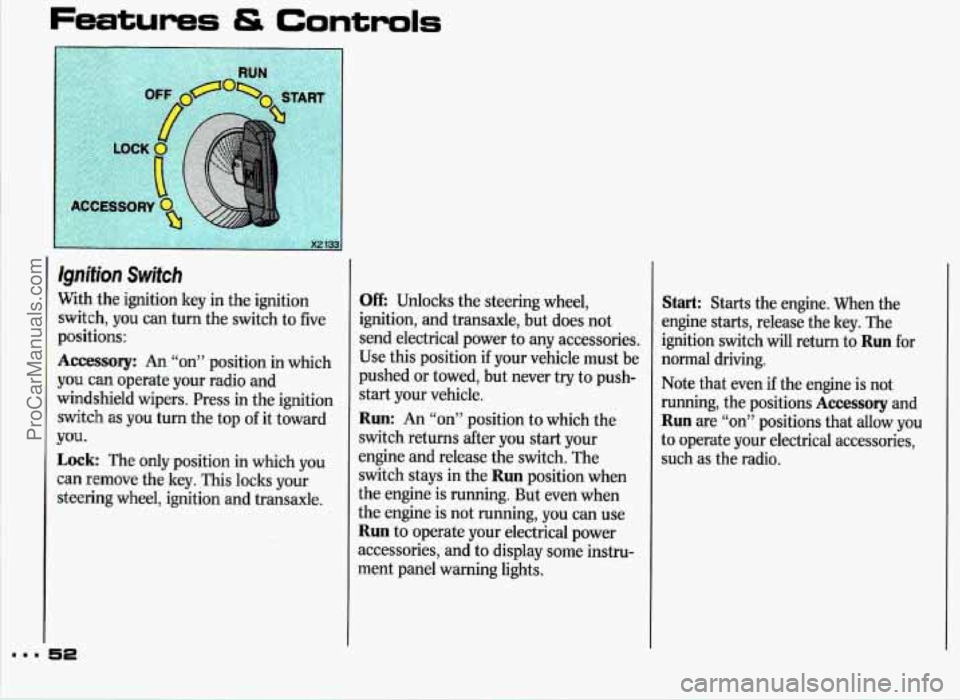
Features & Controls
Qnifion Switch
Nith the ignition key in the ignition
;witch, you can turn the switch to five
~ositions:
kccessory: An “on” position in which
rou can operate your radio and
vindshield wipers. Press in the ignition
;witch as you turn the top of it toward
Lock: The only position in which you
:an remove the key. This locks your
;teering wheel, ignition and transaxle.
TOU.
Off: Unlocks the steering wheel,
ignition, and transaxle, but does not
send electrical power to any accessories,
Use this position if your vehicle must
be
pushed or towed, but never try to push-
start your vehicle.
Run: An “on” position to which the
switch returns after you start your
engine and release the switch. The
switch stays in the
Run position when
the engine is running. But even when
the engine is not running, you can use
Run to operate your electrical power
accessories, and to display some instru-
ment panel warning lights.
Start: Starts the engine. When the
engine starts, release the key. The
ignition switch will return to
Run for
normal driving.
Note that even
if the engine is not
running, the positions
Accessory and
Run are “on” positions that allow you
to operate your electrical accessories,
such
as the radio.
ProCarManuals.com